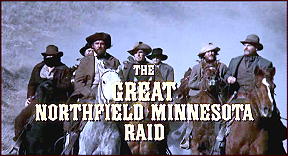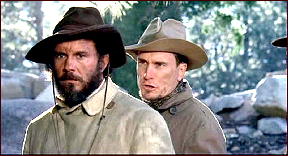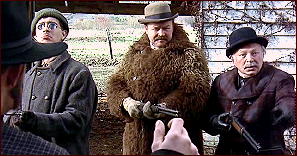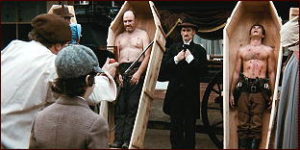Mon 19 Feb 2018
Reviewed by Jonathan Lewis: THE GREAT NORTHFIELD MINNESOTA RAID (1972).
Posted by Steve under Reviews , Western movies[12] Comments
THE GREAT NORTHFIELD MINNESOTA RAID. Universal Pictures, 1972. Cliff Robertson, Robert Duvall, Luke Askew, R.G. Armstrong, Dana Elcar, Donald Moffat, Elisha Cook (Jr.), Royal Dano. Screenwriter-Director: Philip Kaufman.
Filmed in a style that approaches cinéma vérité, Philip Kaufman’s The Great Northfield Minnesota Road has a quasi-documentary feel to it, providing the viewer with an experience that’s almost akin to watching an historical recreation. The movie isn’t so much about plot as it is about atmosphere and, more significantly, about its portraiture of both outlaws and ordinary townsfolk.
Indeed, when it’s at its best, the movie, with its naturalistic performances and lack of artifice allows the audience to be temporarily transported to a small, calm Midwest town in the year 1876 and the midst of great cultural and technological changes.
Enter the outlaws who will wreak havoc in the town. Cliff Robertson and Robert Duvall star, respectively, as Cole Younger and Jesse James in this superbly constructed feature about the Younger Gang’s last and final bank robbery that occurred in the town of Northfield, Minnesota. Both actors portray their characters as both instigators of events and as individuals able to make the most out of life’s circumstances and opportunities after the Confederate loss in the Civil War.
The two are technically in cahoots, but they have very different personalities. Cole is the more introspective of the two; Jesse is the more reckless of the two and betrays a real hatred for the North. He’s also not fully to be trusted. Case in point: when Jesse learns that Cole’s sights are set on Northfield, he attempts to get there before Cole is fully recovered from being wounded in an ambush. Cole, for his part, seems just as intrigued by the societal and technological changes he witnesses in Northfield as he is by his upcoming final bank robbery.
Be on the lookout for the beautiful sequence, filmed documentary style, in which he watches a rudimentary baseball game being played on the outskirts of town with Allen (Dana Elcar), one of the town elders. The message is delivered in a most subtle manner, but it’s abundantly clear. The era of gunslingers is fading away, the anarchic spirit represented by the Younger and James gangs will soon to be replaced by a new, more orderly national pastime, one that will eventually unite a formerly bitterly divided union.
Some might argue that such a sequence takes the viewer out of the film and that it is unnecessary to the plot. But it’s moments like these –and there are a few of them scattered throughout the picture—that are what makes The Great Northfield Minnesota Road stand out from the rather bloated pack of cinematic representations of Cole Younger and Jesse James.





February 19th, 2018 at 6:27 pm
Very perceptive comments on a unique and largely unsung movie.
February 19th, 2018 at 7:25 pm
One of the few films to come close to portraying Jesse James as the backstabbing sociopath he was and not the Dime Novel hero of the Reconstruction era.
An excellent Western, both documentary like and elegaic for a passing era.
February 19th, 2018 at 10:11 pm
I think this is a fairly accurate portrayal of the events of 1876. I live in Northfield, Mn and we have a three day festival known as “The Defeat of Jesse James Days” every September. We aren’t bothered by the fact that according to many historians Jesse James was never in Northfield.
February 20th, 2018 at 5:40 pm
I’ve never researched it (nor have I seen the movie), but I’ve always assumed that Jesse James was there but managed to escape.
February 20th, 2018 at 6:59 pm
Cole Younger was there and spent many years in a Minnesota prison, but he never said that Jesse James was part of the gang.
February 20th, 2018 at 7:43 pm
Randy, Steve,
This is a good example of the John Ford Rule: When the facts conflict with the legend, print the legend.
February 20th, 2018 at 8:28 pm
I know I saw this and Phillip Kaufman is one of favorite directors, but other than a vague memory of Duval’s intensity, I’m drawing a blank on it.
I have a vivid memory of the sets of real life brothers in Walter Hill’s “The Long Ridersâ€. And that it seemed much more interesting.
One of those ill-timed coincidences where two films covering the same materials being released close together probably hindered each movie’s success
February 20th, 2018 at 8:38 pm
David, that is not the John Ford rule. In Liberty valance a newspaper editor says, ‘This is the west…Print The Legend. But this is Fake News as we know it because Mr. Ford has spent the last two hours telling us the truth, and final moment of the film has actor Stewart squirming in his seat when he is unjustly applauded by a train conductor for being the Man who Shot Liberty. He lives in disgrace. So the Ford rule really is, only the truth will do.
February 21st, 2018 at 4:27 pm
Like so many Hollywood films purporting to be “history,” this one seems to follow an unwritten rule: Tell fifty percent of the truth and then, to fulfill dramatic requirements, make up the rest. Even so, it’s hard to hate a movie with such a great cast, seasoned veterans all.
February 23rd, 2018 at 9:07 am
William Goldman once commented on the opening line of BITCH CASSIDY AND THE SUNDANCE KID: “Most of what follows is true.”
He said, “Once you write that, you can write anything.”
February 23rd, 2018 at 5:08 pm
The 19th Century mining town of Jacksonville, Oregon was used by the director and film crew as a stand-in for Northfield, MN. Several of the buildings along Main Street have metal plaques describing its function in the plot, that is, saloon, bank, etc. Jacksonville remains as a tourist destination with an interesting Hollywood connection.
February 23rd, 2018 at 6:56 pm
The settling of Jacksonville is also central to Canyon Passage, both film and novel.